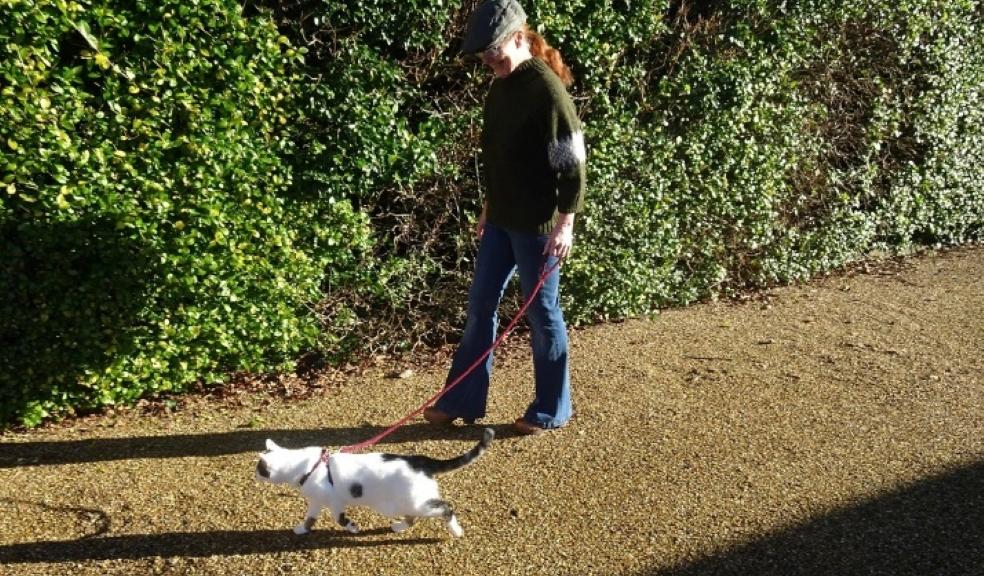
Who let the cats out? The growing UK trend for cat walking
Cat brand Supakit has revealed a growing trend in the UK for walking cats using a harness.
Greater London, Surrey, Kent, Hampshire, Essex, Hertfordshire, Staffordshire, Yorkshire, Lancashire, Devon, Berkshire and Sussex are the top 12 counties for cat walking in the UK, according to sales data from cat accessory brand and training school Supakit, with customers from these regions buying the most cat harnesses in 2021.
Leili Farzaneh, Co-Founder and CEO of Supakit founded the brand with partner Kevin in 2016 after making a breakaway collar for cat and 'serial collar destroyer' Lola, with the first Supakit cat harness introduced in 2018. Contrary to popular belief, Leili says that cats can benefit from training as much as dogs:
"We often do a disservice to cats, thinking of them as solitary creatures that take care of themselves but if we have a cat as a domestic pet, then we have a responsibility to meet their needs. Cats need stimulation just as much as dogs, boredom can be terrible for them, especially if they are house cats. Training of all types is a great way of offering mental stimulation to your cat. Combining that with harness training allows you to open up new sensory experiences outdoors for your cat too.
From interactions with customers, Cat Behaviourist Leili realised that there was a need for advice and support around cat harnessing. The Supakit Academy launched in 2021, with a new course How to Harness Train Your Cat:
"Harness training isn't necessarily about taking your cat on epic adventures or long walks," says Leili. "Cats like to meander, so whilst you might not cover huge distances, you might discover places you've never noticed before. It can be as simple as being able to take your cat into a communal garden using their harness if you live in a flat, or to the vet, particularly if they're not a fan of their carrier.
"Cat training is not only about training the cat, but training the owner too, such as learning to redirect their cat to walk in a new direction without the cat realising, or how to hold the lead to prevent harness escapes.
"In the UK, harness training for cats is an emerging practice. We developed the Supakit Academy to give cat owners the chance to follow a cat centred training programme, taking the owner through every step to their first adventure, with support and advice from Supakit, but also our supportive community.
"The course is online and covers recall training, creating a safe space for your cat when walking, introducing the harness and putting the harness on. It's all about making the process of harness training fun and stress free for both cat and owner, building positive associations."
It's a case of the sooner the better for harness training but older cats can also be trained says Leili:
"Kittens are typically more accepting of new things, so if you're able to, begin harness training while your cat is still young. If the cat is older, they can still be trained, it will just take longer and you will need to be extra patient. As cats are creatures of habit, little and often is best, with 5 minutes of training per day.
"One of the biggest mistakes people make with harness training is just buying a harness and putting it on. It's stressful for the cat, they don't like the harness, and that's the end for most people. With the Supakit Academy, putting the harness on is 14 sessions in. By that point, putting the harness on is fun and stress free.
"Fear of what others might think often puts people off harness training. In the Academy, we build confidence so the owner can read their cat's body language and know they are harness training for the benefit of their cat. Most interest and questions when cat walking comes from a place of curiosity but there are many like-minded people in the UK already enjoying the benefits of harness training for their cats."
Susie Hewer from East Sussex adopted her cat Shelley from a rescue centre. Shelley had been badly burned after hiding inside a car bonnet and was very nervous about the outdoors.
"I'd been advised by the rescue centre that due to Shelley's experiences, she would be best suited to being an indoor cat," said Susie. "We have a large garden, away from people, and I wondered whether I could take Shelley outside on a lead. I tried it once and it didn't go well. I then found Supakit's harnesses and went through the harness training with the Supakit Academy.
"The video tutorials were brilliant and the whole course was about fun and working up to the first outing. I had a trail of cat treats leading to the harness! At first, we practiced just walking around the house on the lead before building up to the garden, and I think it was literally just two steps outside before she ran back in. Now, we're up to about 10 minutes and that is ideal for Shelley, that time outside makes her happy and she has interests both inside the house and outside.
"We've had cats before who were outdoors most of the day, and some cats are like that, but I think it's a misconception that all cats are the same. I'd say don't be afraid to try harness training. The experience may be different to what you imagined, some days your cat might not want to go on the harness, and that's fine. The important thing is that you are getting to understand your cat's needs, and making a positive difference to your cat's life. The help I've had through the Supakit Academy has been fantastic, and I can't recommend it enough."
Experienced Veterinary Surgeon and founder of Our Pets Health, Dr Alex Avery, has worked in general practice in both the UK and New Zealand and says harness training can have multiple benefits for cats:
"Obesity is one of the biggest health issues with cats. Over 60% of cats worldwide are said to be overweight, which can lead to arthritis, diabetes and other health issues which have an impact on the physical health and wellbeing of a cat. Many cat owners can be guilty of showing their love for their pet through food; it is an old wives' tale that cats only eat what they need, they can certainly overeat.
"There can be lots of barriers to letting cats outside to exercise, such as fear of them being knocked over on the road or lost. Yet, if a cat is always indoors, it's often not being given the necessary stimulation to lead a fulfilling life, which can lead to pent up frustrations and stress, as well as medical conditions such as urinary tract disease, over grooming and obesity.
"In addition to the physical benefits of getting more exercise, walking your cat using a harness can be beneficial to their mental wellbeing, help them to satisfy their natural curiosity, and can improve the bond between cat and owner, perhaps making the owner more attuned to their cat's health.
"Before harness training, get your cat microchipped and keep the details up to date, make sure they've had the required vaccinations, flea and worm treatments, and that they are fit and well. A harness should be 'cat-proof', not loose or baggy so they can't escape, but also comfortable and not pinching or pulling on their fur.
"Cats are very clever, kittens have brains like sponges and can easily accept new experiences as normal, but that sponge becomes less absorbent the older your cat is, so have realistic expectations about the time and effort needed when you start harness training. Much of the success with harness training will come down to the temperament of your cat as well as their individual needs. A cat with arthritis, for example, probably isn't going to be suitable for harness training."
For more information about Supakit, visit: https://supakit.co/







